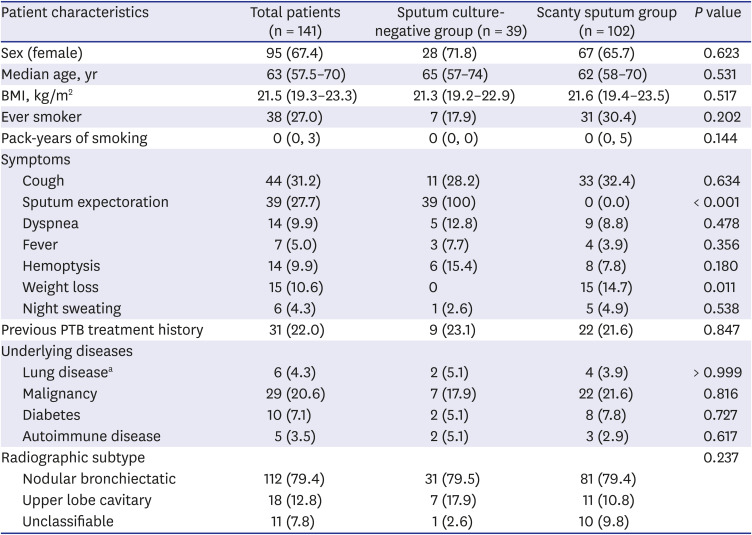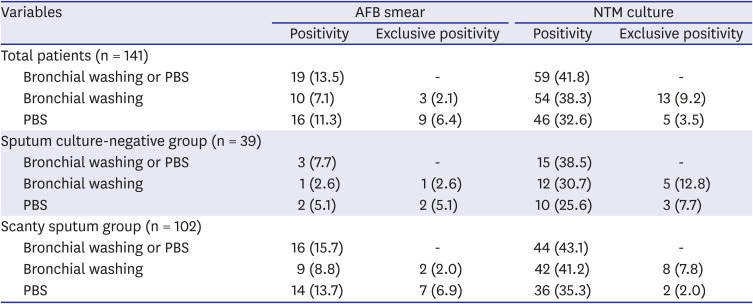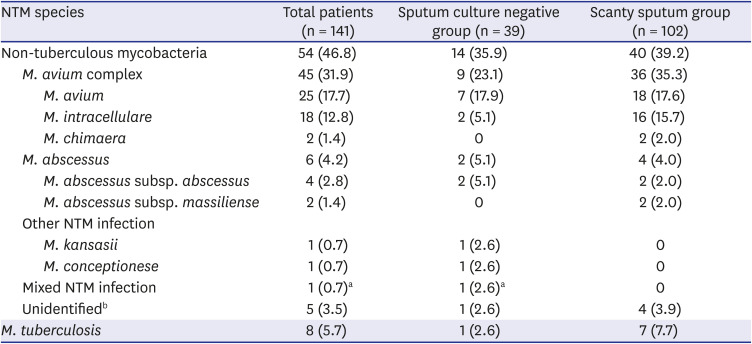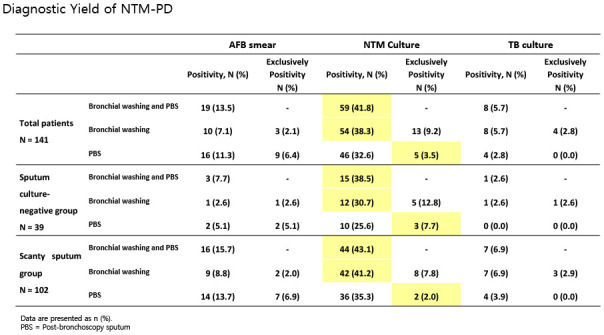1. Haworth CS, Banks J, Capstick T, Fisher AJ, Gorsuch T, Laurenson IF, et al. British Thoracic Society guidelines for the management of non-tuberculous mycobacterial pulmonary disease (NTM-PD). Thorax. 2017; 72(Suppl 2):i1–i64.

2. Daley CL, Iaccarino JM, Lange C, Cambau E, Wallace RJ Jr, Andrejak C, et al. Treatment of nontuberculous mycobacterial pulmonary disease: an official ATS/ERS/ESCMID/IDSA clinical practice guideline. Clin Infect Dis. 2020; 71(4):905–913. PMID:
32797222.

3. Prevots DR, Marras TK. Epidemiology of human pulmonary infection with nontuberculous mycobacteria: a review. Clin Chest Med. 2015; 36(1):13–34. PMID:
25676516.
4. Namkoong H, Kurashima A, Morimoto K, Hoshino Y, Hasegawa N, Ato M, et al. Epidemiology of pulmonary nontuberculous mycobacterial disease, Japan. Emerg Infect Dis. 2016; 22(6):1116–1117. PMID:
27191735.
5. Adjemian J, Frankland TB, Daida YG, Honda JR, Olivier KN, Zelazny A, et al. Epidemiology of nontuberculous mycobacterial lung disease and tuberculosis, Hawaii, USA. Emerg Infect Dis. 2017; 23(3):439–447. PMID:
28221128.

6. Brode SK, Marchand-Austin A, Jamieson FB, Marras TK. Pulmonary versus Nonpulmonary nontuberculous mycobacteria, Ontario, Canada. Emerg Infect Dis. 2017; 23(11):1898–1901. PMID:
29048292.

7. Lee H, Myung W, Koh WJ, Moon SM, Jhun BW. Epidemiology of nontuberculous mycobacterial infection, South Korea, 2007–2016. Emerg Infect Dis. 2019; 25(3):569–572. PMID:
30789139.

8. Tanaka E, Amitani R, Niimi A, Suzuki K, Murayama T, Kuze F. Yield of computed tomography and bronchoscopy for the diagnosis of
Mycobacterium avium complex pulmonary disease. Am J Respir Crit Care Med. 1997; 155(6):2041–2046. PMID:
9196113.
9. Tamura A, Muraki K, Shimada M, Suzuki J, Kashizaki F, Matsui Y, et al. Usefulness of bronchofiberscopy for the diagnosis of pulmonary non-tuberculous mycobacteriosis--an analysis mainly on pulmonary
M. avium complex disease. Kekkaku. 2008; 83(12):785–791. PMID:
19172824.
10. George PM, Mehta M, Dhariwal J, Singanayagam A, Raphael CE, Salmasi M, et al. Post-bronchoscopy sputum: improving the diagnostic yield in smear negative pulmonary TB. Respir Med. 2011; 105(11):1726–1731. PMID:
21840695.

11. Malekmohammad M, Marjani M, Tabarsi P, Baghaei P, Sadr Z, Naghan PA, et al. Diagnostic yield of post-bronchoscopy sputum smear in pulmonary tuberculosis. Scand J Infect Dis. 2012; 44(5):369–373. PMID:
22497518.

12. Aderaye G, G/Egziabher H, Aseffa A, Worku A, Lindquist L. Comparison of acid-fast stain and culture for
Mycobacterium tuberculosis in pre- and post-bronchoscopy sputum and bronchoalveolar lavage in HIV-infected patients with atypical chest X-ray in Ethiopia. Ann Thorac Med. 2007; 2(4):154–157. PMID:
19727366.
13. Jacomelli M, Silva PR, Rodrigues AJ, Demarzo SE, Seicento M, Figueiredo VR. Bronchoscopy for the diagnosis of pulmonary tuberculosis in patients with negative sputum smear microscopy results. J Bras Pneumol. 2012; 38(2):167–173. PMID:
22576423.
14. Du Rand IA, Blaikley J, Booton R, Chaudhuri N, Gupta V, Khalid S, et al. British Thoracic Society guideline for diagnostic flexible bronchoscopy in adults: accredited by NICE. Thorax. 2013; 68(Suppl 1):i1–i44. PMID:
23860341.

15. Lewinsohn DM, Leonard MK, LoBue PA, Cohn DL, Daley CL, Desmond E, et al. Official American Thoracic Society/Infectious Diseases Society of America/Centers for Disease Control and Prevention clinical practice guidelines: diagnosis of tuberculosis in adults and children. Clin Infect Dis. 2017; 64(2):111–115. PMID:
28052967.

16. Griffith DE, Aksamit T, Brown-Elliott BA, Catanzaro A, Daley C, Gordin F, et al. An official ATS/IDSA statement: diagnosis, treatment, and prevention of nontuberculous mycobacterial diseases. Am J Respir Crit Care Med. 2007; 175(4):367–416. PMID:
17277290.

17. Ben Salah I, Adékambi T, Raoult D, Drancourt M.
rpoB sequence-based identification of
Mycobacterium avium complex species. Microbiology (Reading). 2008; 154(Pt 12):3715–3723. PMID:
19047739.
18. Sugihara E, Hirota N, Niizeki T, Tanaka R, Nagafuchi M, Koyanagi T, et al. Usefulness of bronchial lavage for the diagnosis of pulmonary disease caused by
Mycobacterium avium-intracellulare complex (MAC) infection. J Infect Chemother. 2003; 9(4):328–332. PMID:
14691654.
19. Jeon K, Koh WJ, Kwon OJ, Kang EH, Suh GY, Chung MP, et al. Usefulness of bronchoscopy for the diagnosis of nontuberculous mycobacterial pulmonary disease. Tuberc Respir Dis. 2004; 57(3):242–249.

20. Kwak N, Lee CH, Lee HJ, Kang YA, Lee JH, Han SK, et al. Non-tuberculous mycobacterial lung disease: diagnosis based on computed tomography of the chest. Eur Radiol. 2016; 26(12):4449–4456. PMID:
26945763.

21. Urabe N, Sakamoto S, Ito A, Sekiguchi R, Shimanuki Y, Kanokogi T, et al. Bronchial brushing and diagnosis of pulmonary nontuberculous mycobacteria infection. Respiration. Forthcoming. 2021; DOI:
10.1159/000515605.

22. Koh WJ, Yu CM, Suh GY, Chung MP, Kim H, Kwon OJ, et al. Pulmonary TB and NTM lung disease: comparison of characteristics in patients with AFB smear-positive sputum. Int J Tuberc Lung Dis. 2006; 10(9):1001–1007. PMID:
16964791.
23. Kendall BA, Varley CD, Choi D, Cassidy PM, Hedberg K, Ware MA, et al. Distinguishing tuberculosis from nontuberculous mycobacteria lung disease, Oregon, USA. Emerg Infect Dis. 2011; 17(3):506–509. PMID:
21392445.








 PDF
PDF Citation
Citation Print
Print





 XML Download
XML Download